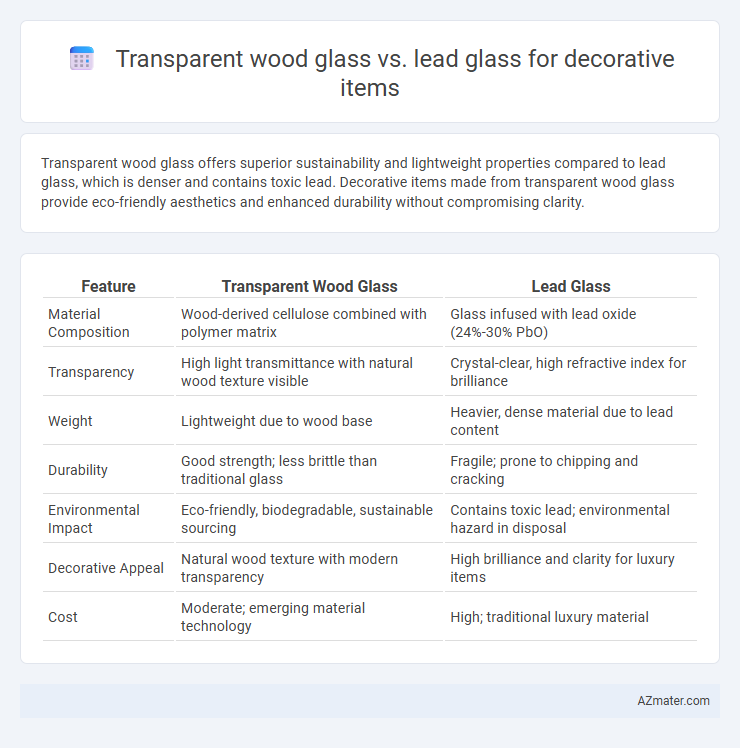Transparent wood glass offers superior sustainability and lightweight properties compared to lead glass, which is denser and contains toxic lead. Decorative items made from transparent wood glass provide eco-friendly aesthetics and enhanced durability without compromising clarity.
Table of Comparison
| Feature | Transparent Wood Glass | Lead Glass |
|---|---|---|
| Material Composition | Wood-derived cellulose combined with polymer matrix | Glass infused with lead oxide (24%-30% PbO) |
| Transparency | High light transmittance with natural wood texture visible | Crystal-clear, high refractive index for brilliance |
| Weight | Lightweight due to wood base | Heavier, dense material due to lead content |
| Durability | Good strength; less brittle than traditional glass | Fragile; prone to chipping and cracking |
| Environmental Impact | Eco-friendly, biodegradable, sustainable sourcing | Contains toxic lead; environmental hazard in disposal |
| Decorative Appeal | Natural wood texture with modern transparency | High brilliance and clarity for luxury items |
| Cost | Moderate; emerging material technology | High; traditional luxury material |
Introduction to Transparent Wood Glass and Lead Glass
Transparent wood glass combines natural wood fibers with transparent resins to create a lightweight, eco-friendly material offering high strength and unique aesthetic warmth, often used in modern decorative items. Lead glass, known for its high refractive index and brilliance due to lead oxide content, provides exceptional clarity and sparkle, traditionally favored in luxury glassware and ornamental pieces. Both materials serve distinct decorative purposes, with transparent wood glass emphasizing sustainability and texture, while lead glass focuses on elegance and light refraction.
Composition and Manufacturing Processes
Transparent wood glass is composed of delignified wood impregnated with transparent polymers, such as epoxy or acrylic resin, offering a sustainable alternative with natural texture and high light diffusion. Lead glass, also known as lead crystal, consists of silica, lead oxide (typically 24-30%), and other metal oxides, manufactured through melting and controlled cooling processes to achieve clarity and brilliance. The manufacturing process of transparent wood glass involves chemical treatment to remove lignin followed by polymer infiltration and curing, whereas lead glass production requires precise melting of raw materials and annealing to prevent internal stresses.
Optical Properties: Clarity and Light Transmission
Transparent wood glass exhibits exceptional clarity with a light transmission rate reaching up to 85%, offering a warm, natural aesthetic that diffuses light softly without glare. Lead glass, known for its high refractive index, provides superior brilliance and sparkle with light transmission around 90%, producing sharp, vivid reflections ideal for decorative items demanding crystal-clear clarity. While transparent wood creates a unique, eco-friendly ambiance through its semi-translucent texture, lead glass excels in delivering precise light refraction and enhanced visual sharpness.
Strength and Durability Comparison
Transparent wood glass offers enhanced strength and durability due to its composite structure, combining natural wood fibers with transparent polymers, resulting in higher impact resistance and better crack resistance compared to traditional lead glass. Lead glass, while known for its clarity and brilliance, is more prone to chipping and breaking under stress due to its brittle nature. For decorative items requiring long-term durability and resistance to mechanical stress, transparent wood glass provides a more resilient and sustainable alternative to lead glass.
Weight and Handling Differences
Transparent wood glass offers a significantly lighter alternative to traditional lead glass, reducing the overall weight of decorative items by up to 50%. This weight difference enhances handling ease, making installation and transportation more efficient and less labor-intensive. Lead glass, while heavier and more fragile, demands careful handling due to its density and susceptibility to breakage, posing challenges in both logistics and long-term durability.
Environmental Impact and Sustainability
Transparent wood glass offers a renewable and biodegradable alternative to lead glass, significantly reducing environmental pollution and toxic waste. Its production relies on sustainable forestry practices and lower energy consumption compared to traditional lead glass manufacturing, which involves hazardous lead compounds that pose health and environmental risks. Transparent wood glass enhances sustainability goals by minimizing carbon footprint and enabling easier recycling, making it a greener choice for decorative items.
Design Versatility and Aesthetic Appeal
Transparent wood glass offers unique design versatility by combining natural wood grain patterns with translucency, creating warm, organic aesthetics that vary with light conditions. Lead glass provides high clarity and brilliant sparkle, enhancing decorative pieces with a luxurious, polished finish ideal for intricate detailing. Both materials enable distinct aesthetic appeals: transparent wood glass emphasizes natural texture and eco-friendly style, while lead glass excels in brilliance and ornate elegance.
Safety and Toxicity Considerations
Transparent wood glass offers superior safety for decorative items due to its non-toxic, biodegradable composition, eliminating risks associated with heavy metals. Lead glass contains lead oxide, posing health hazards like lead poisoning through prolonged exposure or breakage, making it less suitable for home environments. The organic nature of transparent wood glass reduces toxicity concerns, ensuring safer indoor air quality and handling compared to lead-containing glass alternatives.
Cost Analysis for Decorative Applications
Transparent wood glass offers a cost-effective alternative to lead glass for decorative applications, with lower material and manufacturing expenses due to its renewable and abundant raw materials. Lead glass typically incurs higher costs stemming from expensive lead oxide inputs and more complex production processes requiring stringent handling and safety measures. For decorative items, transparent wood glass can significantly reduce overall costs while providing comparable aesthetic appeal and enhanced sustainability credentials.
Future Trends in Decorative Glass Materials
Transparent wood glass offers superior sustainability and energy efficiency compared to lead glass, aligning with increasing environmental regulations and consumer preferences for eco-friendly materials. Innovations in nanotechnology and bio-based composites are driving the development of transparent wood glass with enhanced durability and optical clarity, making it a promising alternative for decorative applications. Lead glass remains valued for its brilliant refractive qualities but faces declining demand due to toxicity concerns and stricter safety standards in interior design and architecture.

Infographic: Transparent wood glass vs Lead glass for Decorative item
 azmater.com
azmater.com